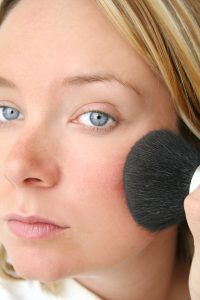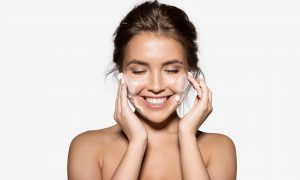The legendary designer Coco Chanel once said, “Nature gives you the face you have at twenty; it is up to you to merit the face you have at fifty.” But with no disrespect to Ms Chanel, she is only partially right. While the right products can help smooth out fine lines and give skin a bit of glow, there are some signs of aging that just creep up on you, no matter how well you take care of your skin. One of those tell-tale signs is broken capillaries.

What are broken capillaries?
Put simply, a broken capillary is an enlarged blood vessel located just below the surface of the skin. Put another way, these red marks are permanently dilated capillaries. The scientific name for them is telangiectasia. They are usually found around the nostrils, and on the cheeks and sometimes the chin. They are also known as spider veins due to their fanned out web shape. They can also look like a network of branches. Spider veins can start off looking like a red patch, but are not the same as rosacea. Although the red veins are harmless, they are one more obstacle standing in the way of flawless skin, and it can be frustrating to have to cover them up every day with foundation or concealer.
What Causes Them?
Broken capillaries are caused by many different factors, and range from genetic to environmental. The walls of capillaries are elastic and flexible, so when they’re frequently dilated due to temperature changes or alcohol consumption, they tend to stay enlarged. Anyone with fair skin, rosacea or acne is likely to have broken capillaries. Injury or trauma to the skin can cause them to appear, and this can run the gamut from popping a pimple to microdermabrasion– the sucking and pulling could cause broken capillaries in sensitive skin. Having a facial from the wrong person may also do more harm than good, if extraction happens with too much pressure to the skin.
Spider veins may even crop up after an illness, brought on by extreme coughing, sneezing or vomiting. If you only have broken capillaries around the nostrils, this could be chalked up to constantly blowing your nose.
The weather can make a difference too. Extreme temperature changes, sunburn and wind burn are another cause, as is overdoing it in the sauna or steam room. UV damage also plays a role, if you need another reason to apply sunscreen. Sun damage can enlarge the blood vessels and draw them closer to the skin. Prolonged exposure to UV rays causes the dermis to thin out, and decreases the amount of collagen, elastin, and hyaluronic acid in the skin. As this happens, the blood vessels become more visible.
Aging plays a role as well, as do hormones. As we get older, collagen and elastin in the skin break down, which makes the skin thinner and weaker. As the skin thins out, veins are more noticeable. A woman’s hormones fluctuate enormously throughout life, so spider veins can show up during times of hormonal changes, such as puberty, pregnancy and menopause.
How to Prevent Broken Capillaries
Even if you are predisposed to having broken capillaries, there are some things you can do to prevent them from forming. Avoid picking at your face, especially with pimples. Don’t touch the spot and instead reach for a drying lotion to tackle the pimple. Skip the overly harsh exfoliating treatments, whether that is a chunky scrub or microdermabrasion, especially if you have sensitive skin. Save the grainy scrubs for your feet and elbows, and choose a gentle but effective chemical exfoliator for your face. They work by gently dissolve dead skin cells with a fruit acid. Formulyst’s Clarifying AHA Cleanser leaves skin clean and exfoliated without any harsh scrubbing, revealing fresh, smooth skin.

Wear sunscreen with a high SPF every single day; this will help stop new broken capillaries from forming, as well as preventing existing ones from looking worse. Capillary walls weaken with UV exposure, so slathering on a good sunscreen is non-negotiable. Take extra steps to protect the face, such as wearing a hat or brushing on mineral makeup which contains a physical sun block, such as zinc. Treat your face with care, especially when cleansing and showering; lower the temperature in the shower and try to rinse with lukewarm water. Otherwise very hot water causes blood vessels to dilate, which increases redness in the skin.
No matter what your skin type is, it’s a good idea to protect your face in harsh weather, such as extreme heat or cold. Be mindful of windburn, especially when doing winter sports such as skiing. Protect your skin with a thick moisturizer and layer on a hydrating serum underneath it. It’s always a good idea to drink plenty of water during the day. Dehydrated skin is thinner and more sensitive, making it susceptible to damage, so make sure you drink at least eight glasses of water a day.
You may also want to avoid vasodilators, which is anything that can cause blood vessels to dilate. Heat, caffeine, alcohol and spicy foods can temporarily cause vessels to fill with blood, which makes capillaries look more pronounced. While they do not cause broken capillaries, they make them look more pronounced.
How To Treat Broken Capillaries
If you have broken capillaries on the face, there are ways to help reduce their appearance. The only way to make a spider vein disappear is in a dermatologist’s office (and even that isn’t a permanent fix). The key is to choose products designed to tackle redness and inflammation, as well as encourage cell turnover to help minimize the appearance of spider veins.
Retinoids are a powerhouse beauty ingredient, known for smoothing out fine lines and fading dark spots. They work by encouraging cell turnover and sloughing off the top layer of the skin to reveal fresher, smoother skin. This vitamin A derivative can also help reduce the appearance of broken capillaries as the cream helps to boost collagen production in the skin and remove the outermost layer of skin. Remember that a little goes a long way and some people find it dry and irritating to the skin.
Start slowly with a pea sized amount, and make sure to wear a sunscreen with minimum SPF 30 every day. Reach for anti-inflammatory ingredients such as rose hip oil, which are thought to calm skin. Keep skin cool with a hydrating mist that contains rose hip oil or green tea extract, or a gel mask.
Some people swear by at home remedies, which focus on tackling inflammation and irritation. If your face feels burned from either the sun or the wind, try applying a soothing cold compress. A bag of frozen peas or a wash cloth chilled in the freezer can be applied to the face, and may also help reduce the appearance of blood vessels. Aloe vera is another option to soothe skin.
Arnica oil is traditionally used to help with healing and bruises, and may help reduce the redness associated with spider veins. One school of thought suggests that astringents such as witch hazel and apple cider vinegar applied to the face may help reduce the appearance of burst blood vessels.
In Office Treatments
A dermatologist can treat broken capillaries with a laser, but keep in mind that multiple treatments are usually necessary to achieve results. The results are not permanent or perfect- they simply keep the capillaries at bay for a year or so. Anyone with darker skin may not be a candidate for some laser treatments. As with any in office procedure, there are associated risks, such as scarring.
Simply put, lasers work by heating the blood inside of the vessels, which causes inflammation and scarring inside the blood vessel. This causes the blood vessel to fade over time, usually over four to six weeks, as they are absorbed by the body. Think of it as zapping the blood vessel.
Some options include the VBeam laser, which targets red spots on the face and causes them to disappear over time. Intense pulled light (IPL) therapy penetrates deep into the skin to treat broken blood vessels.
But tackling spider veins this way can also feel like a game of whack-a-mole. Although the treatment can zero in on a spider vein, a new one may return nearby – which requires another round of treatments.







